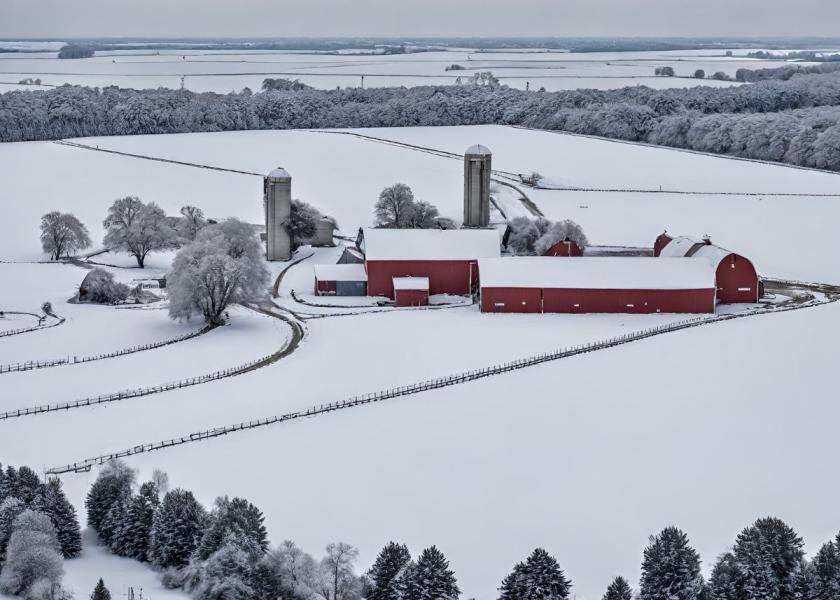7 Tips You Need to Know to Keep Employees Warm

What started as a mild winter is bound to become brutal as heavy snow loads and plummeting temperatures are forecasted to blanket most of the U.S. from coast to coast. While most of the country will stay bundled up inside, farmers and their employees don’t have the luxury of skipping work for a snow day.
To create a safe and comfortable work environment for your farm employees, it’s important to address the specific challenges posed by cold weather on the farm. As temperatures begin to drop, consider implementing the following tips to keep your crew safe, warm and productive:
Make Sure They Have Adequate Clothing
Dressing poorly shouldn’t be considered “cool,” especially when it comes to harsh winter weather conditions on the farm. However, not all employees know how to appropriately dress for the bitter weather. Consider providing them with the following checklist and keeping a few extra items in a bin for employees to use in case they forget.
Some examples of warm winter clothing include:
- Lined jackets
- Lined overalls
- Stocking caps / hats and lined gloves
- Long thermal underwear
- Lined boots – waterproof and anti-slip
- Wicking wool socks
- Scarf
Provide Warm Break Areas
Working out in the cold can take a toll on the body. That’s why it’s necessary to take frequent breaks to rest and warm up. To keep employees going, be sure to create designated warm break areas for your employees to recuperate.
Offer snacks that are not only tasty but also provide energy. Nutritious options like trail mix, energy bars, and fruits can help replenish energy levels. You can also supply a selection of hot beverages like coffee, tea or hot chocolate. If employees are coming in from wet or snowy conditions, consider having a designated area with a drying rack for wet outerwear, gloves, and boots.
Adjust Schedules
Adjusting schedules in the winter is a practical strategy to address the challenges and potential hazards associated with cold weather. Along with allowing more frequent breaks to prevent prolonged exposure to the cold, consider scheduling more grueling outdoor tasks during the warmer parts of the day.
Keep Up Communication
Safety concerns rise as cold weather intensifies. This rings true for not only our employees, but livestock as well. Keep the lines of communication open with employees to address concerns and gather feedback on their comfort and to learn if areas of the farm need immediate attention.
Work in Pairs
While farmers are already hard-pressed to find labor, working in pairs allows employees to get the job done quickly and safely. Using the buddy system ensures that every employee is accounted for and that the work gets done in a timely fashion. This system is especially important for employees working in remote areas.
Have an Emergency Kit
Winter weather can be unpredictable. Having an emergency kit in a well-known location can be a lifesaver when it comes to coping with unexpected challenges. Keep your kit filled with the essentials, such as:
- Medical supplies
- Extra clothing
- Blankets
- Handwarmers
- Flashlights
- Non-perishable snacks
Know the Signs of Cold Stress
Hypothermia and frostbite are the two most common forms of cold stress and can be fatal if left untreated. To help minimize the risk of these conditions going unnoticed, make sure to review and be on the lookout for the following symptoms.
Signs of Hypothermia:
- Fast and shallow breathing / trouble breathing.
- Going from shivering to not shivering.
- Hunger, fatigue and confusion.
- Lack of coordination.
- Increased heart rate.
- Weak pulse.
- Slurred speech / mumbling.
- Dizziness and nausea.
Signs of Frostbite:
- Cold skin, prickling feeling and numbness.
- Red, white, bluish-white or grayish-yellow skin.
- Hard or waxy-looking skin.
- Clumsiness due to joint and muscle stiffness.
- Blistering after rewarming when severe (expect exposed skin to peel off).
- If the skin turns black seek medical attention.
- It can cause the tissue to die which is called gangrene.
For more on weather, read:
- Winter Weather: Find Out What's in Store for Agriculture
- 7 Tips to Protect Farm Buildings from Heavy Snow Loads







